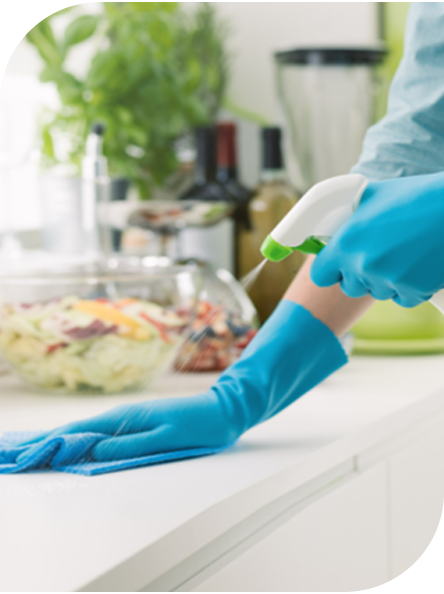Stay Safe – Save Money – Achieve the Best Skin and Hair Ever!
Stay Safe – Save Money – Achieve the Best Skin and Hair Ever!

To keep their home clean and fresh smelling, people use a wide variety of cleaning products. But ingredients in most of these products can be harmful if inhaled or touched. In fact, some of these products are among the most toxic found in the home.
Even Switching to ONE SAFER PRODUCT Can Start Protecting You & Your Family
Harmful Ingredients Enter
Your Body by Inhalation,
Absorption & Ingestion
Over 3.8 million People Die
Yearly - Caused by Avoidable
Toxic Exposures

Over 50% of Household Products
Were Found to Include Toxic Ingredients
Household products many people use do not have to meet any safety standards, and their ingredients do not have to be disclosed, Many emit harmful fumes and include toxic chemicals linked to asthma, cancer, reproductive disorders, hormone disruption and neurotoxicity. The Environmental Working Group reviewed 2,000 household cleaning products and found that 53% contained harmful ingredients.
If a Product You’re Using Has Any of These
Words On Its Label Stop Using
Immediately and Keep Away From Children
“TOXIC” - “HAZARDOUS” - “KEEP OUT OF REACH OF CHILDREN” “DANGER” - “WARNING” - “CAUTION”- “REACTIVE” - “CORROSIVE” “POISONOUS” - “TOXIC” - “FLAMMABLE” - “VOLATILE” - “CAUSTIC” “COMBUSTABLE” - “EXPLOSIVE” - “KEEP IN CHILDPROOF CONTAINER”

Never Use a Product That Doesn’t Disclose
A Full List of Ingredients That You Check For Safety

Here Are Some of the Most Harmful Products
and Safer Alternatives to Help Protect Your Family’s Health
If a child is exposed is exposed to the same amount of a toxin as an
adult, the child (who weighs less) can be affected more than the adult.
Disinfectant Dangers

Cleaning surfaces with disinfectant wipes can disrupt the barrier function of the skin and cause irritation - rashes or tiny splits. This splits invite single cell living organism to enter and that can cause harm to other cells. The Flu and HV are caused by these.
Cleaner Dangers

Many All-Purpose Cleaners contain very toxic grease-cutting agents, solvent chemicals, and/or sudsing agents. These can irritate the skin, eyes, nose and throat, cause cancer and affect the brain and nervous system.
Hand Soap Dangers

Toxic ingredients in traditional soap are used to create lather, scents, and kill bacteria. The FDA estimates that about 40% of soap have at least one toxic ingredient that is not safe.
Laundry Detergent Dangers

The ingredients of laundry detergents are responsible for many household poisonings when stored under a cabinet, in not childproof containers. Adults when using with other cleaning chemicals can create a deadly gas.
Toilet Bowl Cleaner Dangers

A toxic chemical in toilet bowl cleaner is hydrochloric acid, that causes eye and respiratory tract irritation if inhaled and kidney damage. Some people unknowingly add bleach to the bowl and the combination with HCI releases chlorine gas, which can cause breathing problems. Very high levels can cause death.
Window / Mirror Cleaner Dangers

Some window and glass cleaner ingredients cause skin or respiratory irritation, and some are associated with long-term effects such as cancer.
Many Ways You Are Exposed to
Harmful Cleaning Product Ingredients


Harmful Kitchen Products
Avoid Harmful Kitchen Products
Food Containers Dangers

Many plastic containers are contaminated with PFAS. Even small exposures can lead to liver damage, thyroid disease, decreased fertility, hormone suppression and cancer. These toxins are leached into food when warm food is placed in the container or when microwaved.
Cookware Dangers

Exposure to PFOA, a chemical used in non-stick cookware, is linked to ovarian, kidney, and prostate cancers. Another study even links the chemical to rapid weight gain.

Harmful Spray Products
Avoid Harmful Household Sprays
Room Freshener Dangers

The American College of Allergy, Asthma and Immunology, found that many air fresheners contain VOCs, and as much as 20 percent of the population experiences health issues from these products including memory impairment.
Insecticide Dangers

Insecticide fumes that are deadly to insects can also make be poisonous to humans when inhaled, or absorbed through the skin. Some insecticide ingredients cause many organs to become overactive and eventually to stop functioning.
Household Product Toxins Can Reduce Mental Capacity
Here’s Proof That Safer Products Can Produce a Better Quality of Life
Background
A 69-year-old male with, severe memory impairment, and profound fatigue he had been treated with lithium for 25 years, as well as with antidepressants and mood stabilizers for what was believed to be bipolar illness.
Health Problem
Over the last five years, the patient displayed increasing cognitive decline, with escalating memory impairment and social isolation. He had become increasingly dependent on his family for care and support. With the belief that he suffered from irreversible dementia, discussion ensued between family and caregivers about potential placement in an extended care facility for the remainder of his life.
Tested for Toxins
His family was referred to a toxicity clinic that conducted tests revealing he had an accumulation of certain toxic ingredients, one of which was lead. Studies show that 61 percent of hundreds of lipsticks contained lead, including L’Oreal, Cover Girl and even a $24 tube of Dior Addict. Learning the results, the U.S. Food and Drug Administration promised it would conduct an investigation, but it has dragged its feet.
Treatment
Therapies began to diminish the body burden of this toxic metal. The patient and his spouse were educated to make changes in their lives to preclude ongoing exposure to various potential toxicants.
Results
Within six months, the patient noticed considerable improvement in memory and mood. Within one year of treatment, friends and family concluded he had made a dramatic recovery and observed a restoration of his distinctive sense of humor. Six years after his initial visit for environmental health assessment, the patient continues to feel well, now living independently with his spouse and enjoying a good quality of life.
